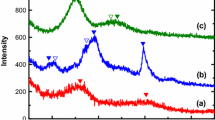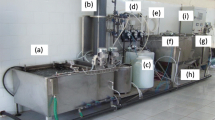Abstract
Purpose
Phosphorus is an essential element that at high concentrations generates eutrophication of aquatic systems. In this study, we used batch and continuous tests to evaluate the efficiency of a Technosol to retain the phosphorus present (as phosphate) in aqueous samples.
Materials and methods
Phosphate sorption on Technosol was studied through batch and continuous experiments. Sorption kinetics and isotherms were investigated at different phosphate loadings and pH. In batch tests, we have determined how the presence of different anions (bicarbonate, sulphate, chloride, chromate and molybdate) affected phosphate retention. In continuous flow systems, phosphate immobilization was assessed as a function of flow rate, pH and Technosol concentration. Finally, the potential reutilization of the column was evaluated using consecutive sorption-desorption cycles.
Results and discussion
Phosphate sorption follows a pseudo-second-order kinetics model and a Langmuir isotherm model. The maximum sorption capacity ranged from 7.1 to 18.5 mg g−1, with larger values obtained at the highest pH. The main mechanisms involved in the sorption process were precipitation (as Ca-P minerals) and surface adsorption. In the column experiments, we observed a sorption reduction from 6.19 ± 0.06 to 2.37 ± 0.06 mg g−1 as the flow rate increased from 1.5 to 5.0 mL min−1. In addition, the retention capacity decreased by 14% when the height of the reactive layer was halved. Finally, the retention capacity of the Technosol spolic silandic recovered well after several sorption-desorption cycles, reaching 40% of the original value after first and second cycles.
Conclusions
The material effectively retained phosphate in batch and continuous flow systems. The Technosol spolic silandic is considered an efficient sorbent to remove the excess of phosphate from the soil solution and the aqueous system. This material may be a useful tool to mitigate or minimize two important environmental problems: eutrophication and the scarcity of natural sources of phosphate. The Technosol can thus be recycled as a phosphate-rich amendment and the leachates can be used to produce liquid fertilizer.









Similar content being viewed by others
References
Antelo J, Avena M, Fiol S, López R, Arce F (2005) Effects of pH and ionic strength on the adsorption of phosphate and arsenate at the goethite–water interface. J Colloid Interface Sci 285:476–486
Antelo J, Arce F, Fiol L (2015) Arsenate and phosphate adsorption on ferrihydrite nanoparticles. Synergetic interaction with calcium ions. Chem Geol 410:53–62
Arnalds O (2008) Andosols. In: Chesworth W (ed) Encyclopedia of soil science. Springer, Dordrecht, pp 39–46
Barca C, Gérente C, Meyer D, Chazarenc F, Andrès Y (2012) Phosphate removal from synthetic and real wastewater using steel slags produced in Europe. Water Res 46:2376–2384
Belelli PG, Fuente SA, Castellani NJ (2014) Phosphate adsorption on goethite and Al-rich goethite. Comput Mater Sci 85:59–66
Borggaard OK, Raben-Lange B, Gimsing AL, Strobel BW (2005) Influence of humic substances on phosphate adsorption by aluminium and iron oxides. Geoderma 127:270–279
Camps M, Madinabeitia Z, Anza Z, Macías-García F, Virgel S, Macías F (2008) Extractability and leachability of heavy metals in Technosols prepared from mixtures of unconsolidated wastes. Waste Manag 28:2653–2666
Coulibaly LS, Akpo SK, Yvon J, Coulibaly L (2016) Fourier transform infra-red (FTIR) spectroscopy investigation, dose effect, kinetics and adsorption capacity of phosphate from aqueous solution onto laterite and sandstone. J Environ Manag 183:1032–1040
Del Nero M, Galindo C, Barillon R, Halter E, Madé B (2010) Surface reactivity of α-Al2O3 and mechanisms of phosphate sorption: in situ ATR–FTIR spectroscopy and ζ potential studies. J Colloid Interface Sci 342:437–444
EC (1991) Directive 91/271/EEC of the European parliament and of the council—on concerning urban waste water treatment. Off J Eur Communities:135/40–135/52
FAO and ITPS (2015) Status of the world’s soil resources (SWSR)—main report. Food and Agriculture Organization of the United Nations and Intergovernmental Technical Panel on Soils, Rome, Italy
Gu X, Xie J, Wang X, Evans LJ (2017) A simple model to predict chromate partitioning in selected soils from China. J Hazard Mater 322:421–429
IUSS Working Group WRB (2015) World reference base for soil resources 2014, update 2015 international soil classification system for naming soils and creating legends for soil maps. World Soil Resources Reports No. 106. FAO, Rome
Karageorgiou K, Paschalis M, Anastassakis GN (2007) Removal of phosphate species from solution by adsorption onto calcite used as natural adsorbent. J Haz Mater A139:447–452
Lehmann A (2006) Technosols and other proposals on urban soils for the WRB (World Reference Base for Soil Resources). Int Agrophys 20:129–134
Liu X, Zhang L (2015) Removal of phosphate anions using the modified chitosan beads: adsorption kinetic, isotherm and mechanism studies. Powder Technol 277:112–119
Liu Y, Sheng X, Dong Y, Ma Y (2012) Removal of high-concentration phosphate by calcite: effect of sulfate and pH. Desalination 289:66–71
Loganathan P, Vigneswaran S, Kandasamy J, Bolan NS (2014) Removal and recovery of phosphate from water using sorption. Crit Rev Env Sci Technol 44:847–907
Luengo C, Brigante M, Antelo J, Avena M (2006) Kinetics of phosphate adsorption on goethite: comparing batch adsorption and ATR-IR measurements. J Colloid Interface Sci 138:12–19
Manning BA, Goldberg S (1996) Modeling competitive adsorption of arsenate with phosphate and molybdate on oxide minerals. Soil Sci Soc Am J 60:121–131
Mezenner NY, Bensmali A (2009) Kinetics and thermodynamic study of phosphate adsorption on iron hydroxide-eggshell waste. Chem Eng J 147:87–96
Millero F, Huang F, Zhu X, Liu X, Zhang JZ (2001) Adsorption and desorption of phosphate on calcite and aragonite in seawater. Aquat Geochem 7:33–56
Monterroso C, Macías F, Gil Bueno A, Val Caballero C (1998) Evaluation of the land reclamation project at the As Pontes Mine (NW Spain) in relation to the suitability of the soil for plant growth. Land Degrad Dev 9:441–451
Murphy J, Riley JP (1962) A modified single solution method for the determination of phosphate in natural waters. Anal Chim Acta 27:31–36
Novo LAB, Covelo EF, González L (2013) Phytoremediation of amended copper mine tailings with Brassica juncea. Int J Min Reclam Env 27:215–227
Parkhurst DL, Appelo CAJ (2013) Description of input and examples for PHREEQC version 3—a computer program for speciation, batch- reaction, one-dimensional transport, and inverse geochemical calculations: U.S. Geological Survey Techniques and Methods, book 6, chap A43
Perassi I, Borgnino L (2014) Adsorption and surface precipitation of phosphate onto CaCO3–montmorillonite: effect of pH, ionic strength and competition with humic acid. Geoderma 232–234:600–608
Pérez C, Antelo J, Fiol S, Arce F (2014) Modeling oxyanion adsorption on ferralic soil, part 2: chromate, selenate, molybdate, and arsenate adsorption. Environ Toxicol Chem 33:2217–2224
Rodríguez-Vila A, Asensio V, Forján R, Covelo EF (2016) Assessing the influence of technosol and biochar amendments combined with Brassica juncea L. on the fractionation of Cu, Ni, Pb and Zn in a polluted mine soil. J Soils Sediments 16:339–348
Rout PR, Dash RR, Bhunia P (2014) Modelling and packed bed column studies on adsorptive removal of phosphate from aqueous solutions by a mixture of ground burnt patties and red soil. Adv Environ Res 3:231–251
Rout PR, Bhunia P, Dash RR (2017) Evaluation of kinetic and statistical models for predicting breakthrough curves of phosphate removal using dolochar-packed columns. J Water Process Eng 17:168–180
Santos ES, Magalhães MCF, Abreu MM, Macías F (2014) Effects of organic/inorganic amendments on trace elements dispersion by leachates from sulfide-containing tailings of the São Domingos mine, Portugal. Time evaluation. Geoderma 226-227:188–203
Santos ES, Abreu MM, Macías F, de Varennes A (2016) Chemical quality of leachates and enzymatic activities in Technosols with gossan and sulfide wastes from the São Domingos mine. J Soils Sediments 16:1366–1382
Smith VH, Joye SB, Howarth RW (2006) Eutrophication of freshwater and marine ecosystems. Limnol Oceanogr 51:351–355
Sparks DL, Page AL, Helmke PA, Loeppert RH (1996) Methods of soil analysis part 3—chemical methods. SSSA Book Ser. 5. Soil Science Society of America, America Society of Agronomy, Madison, Wisconsin, USA
Vohla C, Kõiv M, Bavor HJ, Chazarenc F, Mander U (2011) Filter materials for phosphorus removal from wastewater in treatment wetlands—a review. Ecol Eng 37:70–89
Wang Z, Shi M, Li J, Zheng Z (2014) Influence of moderate pre-oxidation treatment on the physical, chemical and phosphate adsorption properties of iron-containing activated carbon. J Environ Sci 26:519–528
Westholm LJ (2006) Substrates for phosphorus removal—potential benefits for on-site wastewater treatment? Water Res 40:23–36
Woumfo ED, Siéwé JM, Njopwouo D (2015) A fixed-bed column for phosphate removal from aqueous solutions using an andosol-bagasse mixture. J Environ Manag 151:450–460
Xi B, Zhao Y, Zhang L, Xia X, Luan Z, Peng X, Lv W (2014) Return chemical sludge employed in enhancement of phosphate removal from wastewater. Desalin Water Treat 52:6639–6647
Xie J, Lin Y, Li C, Wu D, Kong H (2015) Removal and recovery of phosphate from water by activated aluminum oxide and lanthanum oxide. Powder Technol 269:351–357
Xu N, Christodoulatos C, Braida W (2006) Modeling the competitive effect of phosphate, sulfate, silicate, and tungstate anions on the adsorption of molybdate onto goethite. Chemosphere 64:1325–1333
Yan GY, Viraraghavan T, Chen M (2001) A new model for heavy metal removal in a biosorption column. Adsorp Sci Technol 19:25–43
Zeng L, Li XM, Liu JD (2004) Adsorptive removal of phosphate from aqueous solutions using iron oxide tailings. Water Res 38:1318–1326
Acknowledgements
This work was supported by the Group of Excellence GI-1245, AMBIOSOL (Instituto de Investigaciones Tecnológicas − Universidad de Santiago de Compostela; GRC2014/003) financed by Xunta de Galicia and by the INTERREG V-A POCTEP Program (0366/RES2VALHUM/1/P). The authors belong to the CRETUS Strategic Partnership (AGRUP2015/02), co-funded by FEDER (UE). The authors thank the company CVAN (Centro de Valorización Ambiental del Norte. Touro, Spain) for preparing and supplying the Technosol. Two anonymous reviewers are gratefully acknowledged for their feedback and constructive comments, which have greatly contributed to improve this manuscript.
Author information
Authors and Affiliations
Corresponding author
Additional information
Responsible editor: Stefan Norra
Electronic supplementary material
ESM 1
(DOCX 159 kb)
Rights and permissions
About this article
Cite this article
Arán, D., Antelo, J., Fiol, S. et al. Immobilization of phosphate by a Technosol spolic silandic: kinetics, equilibrium and dependency on environmental variables. J Soils Sediments 18, 2914–2923 (2018). https://doi.org/10.1007/s11368-018-1970-y
Received:
Accepted:
Published:
Issue Date:
DOI: https://doi.org/10.1007/s11368-018-1970-y




